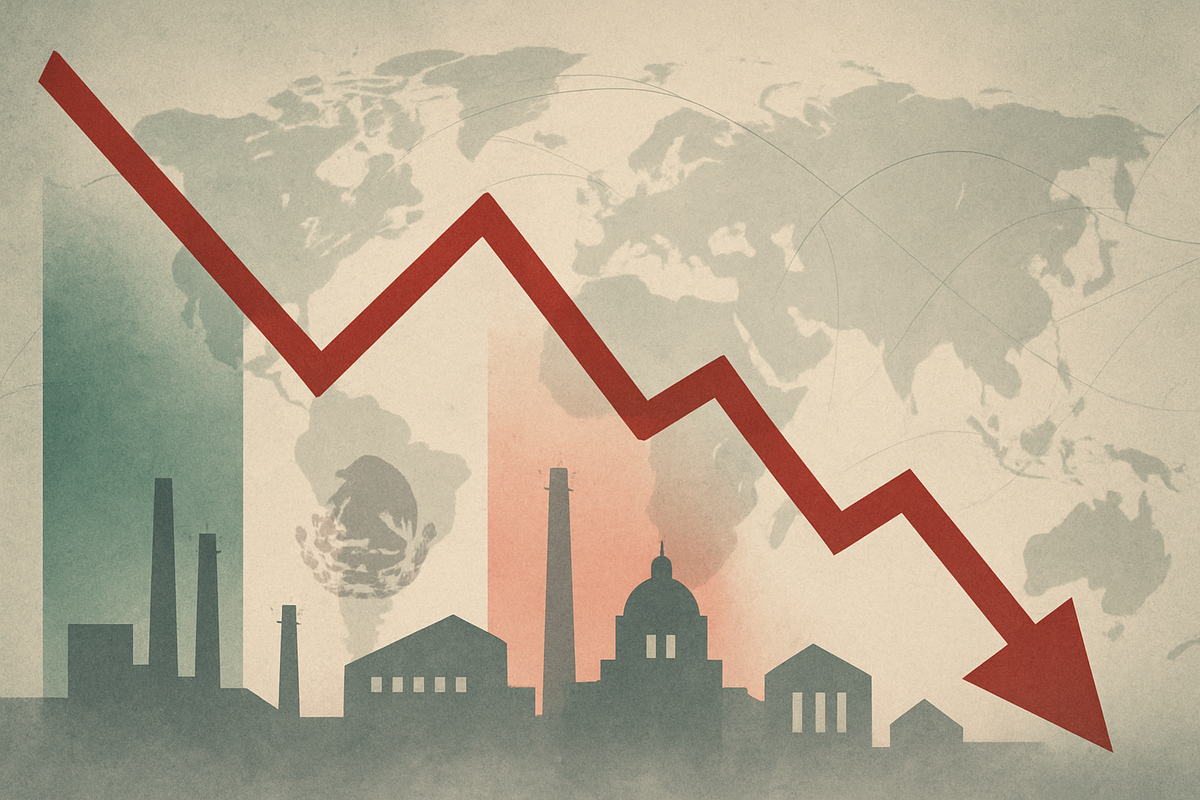
As October 2025 unfolds, financial markets are keenly awaiting the official economic data for the third quarter, with particular attention on key emerging economies. While specific figures for Mexico's Q3 2025 Gross Domestic Product (GDP) are yet to be released, a hypothetical scenario of economic contraction in the Latin American powerhouse is a topic of considerable discussion among analysts. Such a downturn, if it materializes, would signal a significant slowdown in economic activity, potentially stemming from a confluence of global and domestic pressures, and could send ripples of uncertainty across the broader emerging markets landscape. The implications could range from a broad shift in investor sentiment and capital outflows to currency depreciation and a re-evaluation of growth prospects for the entire asset class.
The Looming Shadow: A Detailed Look at a Hypothetical Mexican Downturn
Should Mexico's Q3 2025 GDP figures indeed reveal a contraction, the specific details would likely point to a broad-based deceleration across several key economic indicators. A decline in consumer spending, a crucial component of GDP, could be attributed to persistent inflationary pressures eroding household purchasing power, coupled with potentially stagnant wage growth or rising unemployment. Furthermore, a significant drop in both public and private investment would be a strong indicator of waning business confidence, possibly fueled by regulatory uncertainties, shifts in government policy impacting critical sectors like energy, or a general apprehension about future economic stability.
The timeline leading up to such a hypothetical contraction would likely involve a series of preceding indicators flashing warning signs. These could include several consecutive months of declining industrial production, a downturn in retail sales, and a slowdown in export growth, particularly to the United States (NYSE: US), Mexico's largest trading partner. Persistent high interest rates, maintained by the Banco de México (Banxico) in an effort to curb inflation, could also contribute by making borrowing more expensive for businesses and consumers, thus stifling investment and consumption. Key players and stakeholders involved in such a scenario would include the Mexican government, grappling with fiscal policy responses; Banxico, navigating monetary policy; major domestic and international corporations with significant operations in Mexico; and, of course, the Mexican populace, directly impacted by economic hardship. Initial market reactions to a confirmed contraction would likely be swift and negative, potentially leading to a sharp depreciation of the Mexican Peso (MXN) against major currencies, a sell-off in Mexican equities, and a widening of bond spreads, reflecting increased perceived risk by investors.
Corporate Fortunes in Flux: Winners and Losers
A hypothetical economic contraction in Mexico would undoubtedly create a challenging environment for many businesses, while potentially presenting opportunities for a select few. Companies heavily reliant on domestic consumer spending, such as retail giants like Walmex (BMV: WALMEX) (Walmart de México y Centroamérica) and Femsa (BMV: FEMSAUBD) (Fomento Económico Mexicano S.A.B. de C.V.), which operates Oxxo convenience stores, would likely face significant headwinds. Reduced purchasing power and cautious consumer behavior would directly impact their sales volumes and profit margins. Similarly, construction and infrastructure companies, such as Cemex (BMV: CEMEXCPO) (Cemex S.A.B. de C.V.), could see project delays or cancellations due to decreased public and private investment, leading to lower demand for building materials.
Conversely, some sectors and companies might prove more resilient or even benefit. Export-oriented manufacturers, particularly those serving robust markets outside of Mexico or those benefiting from a weaker peso making their goods cheaper internationally, could potentially mitigate domestic slowdowns. However, their fortunes would still be tied to global demand. Companies in essential services, such as utilities or certain segments of healthcare, might experience more stable demand. Furthermore, businesses with strong balance sheets, low debt, and diversified revenue streams across different geographies or product lines would be better positioned to weather the storm. In a scenario of heightened economic uncertainty, financial institutions with significant exposure to struggling domestic businesses or consumers could face increased non-performing loans, while those with conservative lending practices and diversified portfolios might be more insulated.
Broader Implications for Global Economic Stability
A hypothetical economic contraction in Mexico, a significant emerging market and the second-largest economy in Latin America, would not occur in isolation. Such an event would inevitably fit into broader industry trends of increasing global economic fragmentation and vulnerability, particularly for nations heavily reliant on trade and foreign investment. It could serve as a stark reminder of the interconnectedness of global supply chains and financial markets, especially with the United States. Potential ripple effects would extend to other Latin American economies, which often experience contagion from their larger neighbors, leading to a region-wide re-evaluation of investment prospects. Trade partners, particularly those integrated into the North American supply chain, might also feel the pinch as demand from Mexico falters.
Regulatory and policy implications would be substantial. The Mexican government might be compelled to introduce fiscal stimulus packages or implement reforms aimed at boosting investor confidence and consumption. Banxico would face the difficult task of balancing inflation control with economic growth, potentially leading to debates over interest rate policy. Internationally, such a contraction could prompt global financial institutions to revise down their growth forecasts for emerging markets as a whole, potentially triggering a broader flight to quality among investors, away from riskier assets. Historically, similar slowdowns in major emerging economies, such as the Asian Financial Crisis in the late 1990s or the Latin American debt crisis, demonstrate how quickly localized economic issues can escalate into regional or even global concerns, leading to significant capital outflows and increased market volatility.
What Comes Next: Navigating the Uncertainty
Looking ahead, if Mexico were to confirm an economic contraction in Q3 2025, the short-term outlook would be characterized by heightened market volatility and a cautious approach from investors. The immediate focus would shift to whether the contraction is an isolated event or the beginning of a more prolonged recession. In the short-term, we could anticipate a period of market instability, with the Mexican peso likely remaining under pressure and local equity markets experiencing further declines. Businesses operating in Mexico might implement cost-cutting measures, delay expansion plans, or re-evaluate their investment strategies to brace for a potentially tougher economic climate.
Long-term possibilities would hinge on the policy responses from the Mexican government and Banxico, as well as the broader global economic environment. Effective fiscal stimulus, combined with credible monetary policy aimed at stabilizing prices without unduly stifling growth, would be crucial for a recovery. Strategic pivots for companies might include diversifying supply chains, focusing on operational efficiencies, or exploring new markets outside of Mexico to mitigate domestic risks. Market opportunities could emerge for investors willing to take on higher risk, seeking undervalued assets in anticipation of a future recovery. Conversely, significant challenges would include managing currency risk, navigating a potentially weak consumer environment, and dealing with increased borrowing costs. Potential scenarios range from a swift, V-shaped recovery, driven by strong policy action and a rebound in global demand, to a more protracted U-shaped or even L-shaped downturn if underlying structural issues are not addressed or global conditions deteriorate further.
A Critical Juncture for Emerging Markets
The hypothetical economic contraction in Mexico during Q3 2025, while still awaiting official confirmation, serves as a critical bellwether for the broader emerging markets landscape. The key takeaways from such a scenario would underscore the inherent vulnerabilities of these economies to both global economic shifts and domestic policy challenges. It highlights the delicate balance central banks and governments must strike between combating inflation, fostering growth, and maintaining investor confidence.
Moving forward, the market will be closely scrutinizing not only the official Q3 GDP data for Mexico but also subsequent economic indicators and policy announcements from Mexico City. Investors should watch for signs of stabilization in inflation, any shifts in Banxico's monetary policy stance, and the government's fiscal response. Furthermore, the performance of key trading partners, especially the United States, will remain paramount, given its significant influence on Mexico's export sector and overall economic health. This period represents a critical juncture where proactive policy-making and resilient corporate strategies will be essential in navigating the potential headwinds and ensuring long-term stability and growth within emerging markets.
This content is intended for informational purposes only and is not financial advice






